
Art Nouveau is an international style of art, architecture, and applied art, especially the decorative arts. The style is known by different names in different languages: Jugendstil in German, Stile Liberty in Italian, Modernisme in Catalan, and also known as the Modern Style in English. Art Nouveau was popular during the Belle Époque period that ended with the start of World War I in 1914. It was a reaction against the academic art, eclecticism and historicism of 19th century architecture and decoration. Other characteristics of Art Nouveau were a sense of dynamism and movement, often given by asymmetry or whiplash lines, and the use of modern materials, particularly iron, glass, ceramics and later concrete, to create unusual forms and larger open spaces.

The Exposition Universelle of 1900, better known in English as the 1900 Paris Exposition, was a world's fair held in Paris, France, from 14 April to 12 November 1900, to celebrate the achievements of the past century and to accelerate development into the next. It was held at the esplanade of Les Invalides, the Champ de Mars, the Trocadéro and at the banks of the Seine between them, with an additional section in the Bois de Vincennes, and it was visited by more than 50 million people. Many international congresses and other events were held within the framework of the Exposition, including the 1900 Summer Olympics.
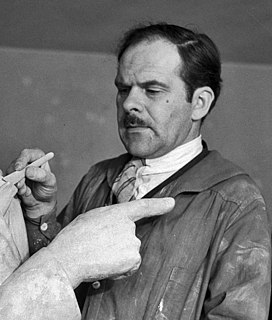
Alexander Porfyrovych Archipenko was a Ukrainian and American avant-garde artist, sculptor, and graphic artist. He was one of the first to apply the principles of Cubism to architecture, analyzing human figure into geometrical forms.
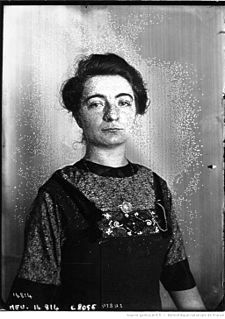
Lucienne Heuvelmans (1885–1944) was a French sculptor and illustrator.

Julio González i Pellicer, born in Barcelona, was a Spanish sculptor and painter who developed the expressive use of iron as a medium for modern sculpture. He was from a lineage of metalsmith workers and artists. His grandfather was a goldsmith worker and his father, Concordio González, a metalsmith worker who taught him the techniques of metalsmith in his childhood years. His mother, Pilar Pellicer Fenés, came from a long line of artists.

Yevgeny Yevgenyevich Lanceray, also often spelled Eugene Lansere, was a Russian graphic artist, painter, sculptor, mosaicist, and illustrator, associated stylistically with Mir iskusstva.

Kasli is a town and the administrative center of Kaslinsky District in Chelyabinsk Oblast, Russia, located among several lakes on the eastern slope of the Middle Urals, 87 kilometers (54 mi) northwest of Chelyabinsk, the administrative center of the oblast. Population: 16,969 (2010 Census); 19,091 (2002 Census); 21,530 (1989 Census).

Cast-iron architecture is the use of cast iron in buildings and objects, ranging from bridges and markets to warehouses, balconies and fences. Refinements developed during the Industrial Revolution in the late 18th century made cast iron relatively cheap and suitable for a range of uses, and by the mid-19th century it was common as a structural material, and particularly for elaborately patterned architectural elements such as fences and balconies, until it fell out of fashion after 1900 as a decorative material, and was replaced by modern steel and concrete for structural purposes.

Vincenzo Brenna was an Italian architect and painter who was the house architect of Paul I of Russia. Brenna was hired by Paul and his spouse Maria Fyodorovna as interior decorator in 1781 and by the end of 1780s became the couple's leading architect. Brenna worked on Pavlovsk Palace and Gatchina palaces, rebuilt Saint Isaac's Cathedral, and most notably created Saint Michael's Castle in Saint Petersburg. Most of his architectural works were created concurrently during Paul's brief reign. Soon after Paul was murdered in a palace coup Brenna, renowned for fraud and embezzlement barely tolerated by his late patron, retired and left Russia for an uneventful life in Saxony.

Samuel Aloysius Murray was an American sculptor, educator, and protégé of the painter Thomas Eakins.

Matthew Afanasyevich Chizhov (1838–1916) was a Russian sculptor.
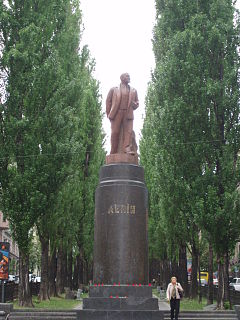
The year 1946 was marked by many events that left an imprint on the history of Soviet and Russian fine arts.
The year 1944 was marked by many events that left an imprint on the history of Soviet and Russian Fine Arts.
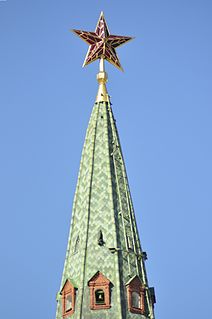
The year 1937 was marked by many events that left an imprint on the history of Soviet and Russian Fine Arts.
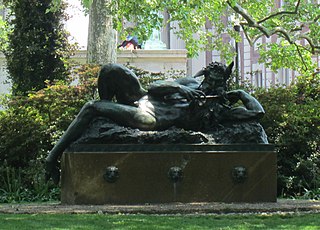
The Great God Pan is a bronze sculpture by American sculptor George Grey Barnard. Since 1907, it has been a fixture of the Columbia University campus in Manhattan, New York City.

The fine art of Leningrad is an important component of Russian Soviet art—in the opinion of the art historians Vladimir Gusev and Vladimir Leniashin, "one of its most powerful currents". This widely used term embraces the creative lives and the achievements of several generations of Leningrad painters, sculptors, graphic artists and creators of decorative and applied art from 1917 to the early 1990s.
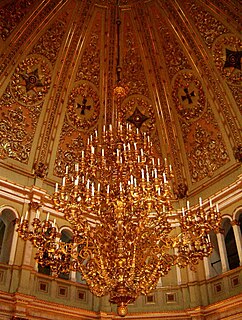
Félix Chopin (1813-1892) was a French bronze designer.
Nikolai Alexandrovich Romanov is a Russian and Soviet painter, who lives and works in Saint Petersburg.
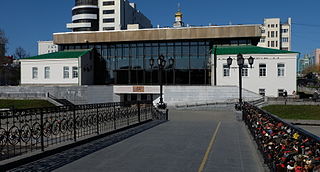
The Yekaterinburg Museum of Fine Arts, established in 1986, is the largest art museum of the Urals region of Russia. It is based in Voevodina Street on the banks of the Iset River in the city of Yekaterinburg.

Nikolay Akimovich Laveretsky was a Russian sculptor and art professor.























